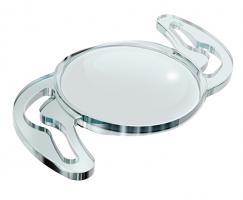
Rayner marks ten years of C-flex in the USA
Posted on 24/04/2017
For immediate release.
Rayner marks ten years of C-flex in the USA
14 March 2017. Worthing, United Kingdom. Rayner announced today that it will mark an important milestone next month: the ten year anniversary of US Food and Drug Administration (FDA) approval of C-flex 570C monofocal Intraocular Lens (IOL) for commercial use in the United States of America.
C-flex — the first IOL from a non-American manufacturer in over two decades to gain FDA approval — is a key product in Rayner’s portfolio and is one of the company’s most implanted lenses globally. It is based on the platform used across all of Rayner’s current and pipeline capsular bag IOLs.
Dr James A Davison at the Wolfe Clinic, Marshalltown, Iowa, implanted the first US patient with a C-flex IOL on October 24, 2003 as part of the international, multi-site clinical study. Dr Davison said: “It was a great privilege to be part of the study for the Rayner foldable acrylic IOL and I join in celebrating its 10 year anniversary. This lens has a unique and extremely stable three dimensional haptic structure and beautifully clear optic. It is easy to implant and centers very predictably. I really enjoy seeing it in my patients today.”
Dating back to the early ‘80s, Rayner has a strong history of working with US surgeons. Their Choyce MkVIII and MkIX anterior chamber designs were not only the first Rayner IOLs to be approved for commercial use in the USA, but were also the first lenses ever to be approved by the FDA as safe and effective.
Rayner CEO, Tim Clover, said: “I would like to personally thank all surgeons who have contributed to our growth in the USA. We will continue to work hard in providing the US market with access to existing products as well as products in our pipeline, all with the ambition of delivering better patient outcomes.”
Why do surgeons like C-flex?
With it’s closed C-loop haptics, the C-flex monofocal IOL is based on a proven design and is implantable through a 2.2 mm incision. Anti-vaulting haptic technology provides excellent refractive outcomes[1] and stable centration[2], and because the IOL is manufactured from Rayacryl, surgeons can expect a material free from vacuoles and glistenings[7] with excellent uveal biocompatibility[9] and low inflammatory responses[10].
Another key C-flex feature is the Amon-Apple square edge which creates an optimum barrier to reduce epithelial cell migration[6, 15] and yet shows no general increase in glare from previous models[7]; the overall lens design reducing dysphotopsia[14].
In addition to the C-flex Spherical monofocal, the C-flex Aspheric monofocal IOL, the RaySert PLUS Mini Incision IOL Injection System for C-flex Aspheric and the Single Use Soft-Tipped Injector are also available for commercial use in the USA.
To view the original press release announcing the launch of C-flex in the USA please click here.
 [ENDS]
[ENDS]
About Rayner Rayner is a leading developer and manufacturer of ophthalmic implants and pharmaceuticals. When Sir Harold Ridley designed the world’s first IOL in 1949, he chose Rayner to manufacture this ground-breaking invention.
With more than 65 years of continuous growth and experience, we remain at the forefront of innovation. We are focused on providing the best visual outcomes for clinicians and patients and are driven by science to improve performance and safety.
Headquartered in Worthing, United Kingdom, Rayner markets its IOL portfolio and related products worldwide in over 80 countries through a network of distributors and includes direct sales teams in the United Kingdom, USA, Germany & Austria, Italy and Spain.
For general enquiries or to arrange an interview, please contact Rayner: iol_enquiries@rayner.com
Not all Rayner products are approved for sale in every country. Please contact your local Rayner distributor for details of which products are available in your area.
References
1. Percival SPB et al. Eye 2002 May;16(3):309–315
2. Alberdi R et al. J Refract Surg. 2012;28(10):696-700
7. Rayner data on file
9. Tomlins PJ et al. J Cataract Refract Surg. 2014; 40:618–625
10. Richter-Mueksch S et al. J Cataract Refract Surg. 2007; 33:1414–1418
6. Mathew RG and Coombes AGA. Ophthalmic Surg Lasers Imaging. 2010 Nov-Dec;41(6):651-5
15. Vyas A et al. J. Cataract Refract Surg 2007, 33:81-87
7. Rayner data on file
14. Vyas A. Clin Exp Ophthalmol 2015, 6(1):391